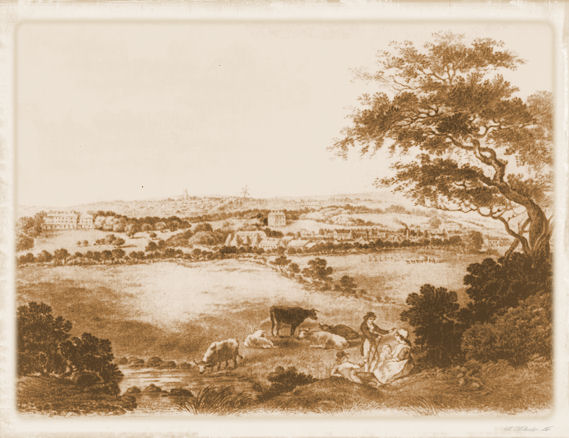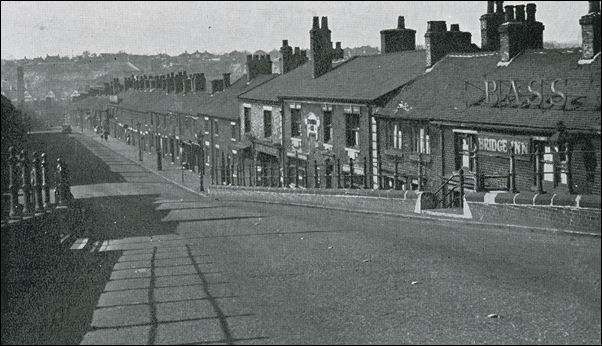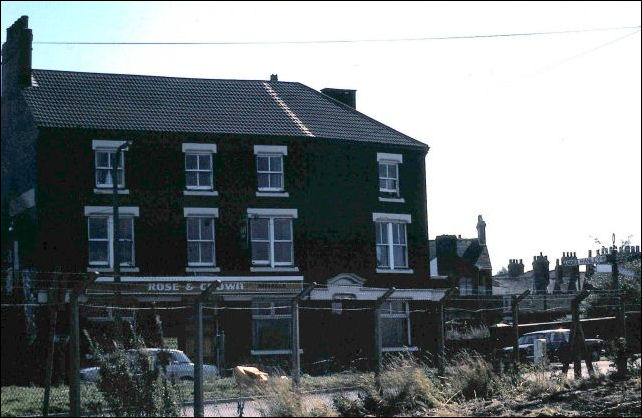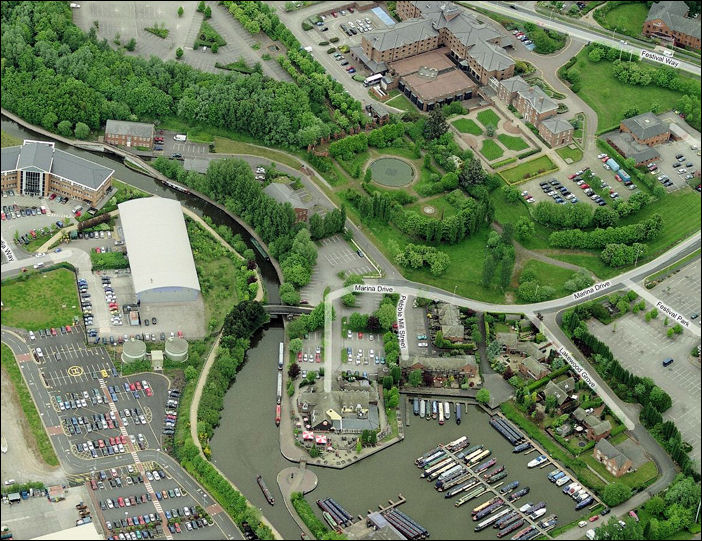|
Hard times they must have been in Etruria in those
days

Etruria Valley prior to
1840
This engraving was discovered in the rubble of the Etruria Pottery in
1963.
It depicts the rural Etruria Valley prior to 1840, showing clearly the
Wedgwood Pottery Factory in the middle distance with Etruria Hall behind.
Can you imagine the view Josiah Wedgwood had when he looked out from Cob Ridge above the smoky potteries of Burslem and Shelton on the day he purchased Ridge House estate? He bought the land from Mrs Ashenhurst a heiress of the Roundhead Parliamentarian Colonel Ashenhurst who, under Oliver Cromwell, had laid siege with the notorious gun, Roaring Meg – today’s equivalent of a weapon of mass destruction – upon Biddulph Hall.
The new Wedgwood estate comprised of 350 acres of a wide gently sloping meadowland descending into a lush valley and rising on the other side to the woodland ridges of Wolstanton and Hartshill. Here the great potter built his thirty-four room mansion surrounded by lavish gardens as a retreat often used as the monthly meeting place for the Lunar Society whose members included the science icons of the Industrial Revolution, James Watt, Erasmus Darwin, Joseph Priestley and William Boulton.
As well as the house the enterprising and creative Wedgwood built the district’s most modern potbank with all the best mechanical installations he could devise to produce the finest ware the world had seen since the ancient classical civilisations. Closer to the valley basin, near to the Fowlea Brook, he supported the construction of James Brindley’s canal and erected a long row of cottages for his workers as an inducement and reward for their trust and loyalty and their expertise. And then he called the completed venture Etruria in tribute to the ancient Italian region whose ceramic art he so admired.
Later the powerful capitalists Granville’s came to Etruria where they set down mines and blast furnaces and tore up the land in pursuit of mineral wealth and the manufacture of heavy sheets of iron and steel. This was industry that thundered 24 hours a day while the red skies of Etruria, Hell-like, lit-up the whole of Stoke-on-Trent and that once luxuriant valley. In spite of all this turmoil Wedgwood’s cottages stayed together around which a newer enlarged community of Etruria was formed. More houses were added to the cottages with a central thoroughfare named Lord Street.

The
Kathleen Ferrier Memorial Hall, Etruria
pen drawing by Neville
Malkin - August 1974
[since demolished]
Kath Hopcroft is the daughter of a very famous Etruscan, Harry Vincent, who was the director of the Etruscan Choral Society – the man who brought the stunning contralto Kathleen Ferrier to the Potteries. The Vincent’s owned a shoe repair shop in Lord Street which served as a meeting place for local and national musicians discussing concert programmes and venues.
“It was a long street,” Kath remembers, “reaching from the two pubs that lay below the canal by Wedgwood’s called the Etruria and the Bridge. Of course the factory of Wedgwood’s had moved by this time to Barlaston and the old pottery works was used as a store for Dunlop Tyres. I remember Lord Street as a solid row of terraces that ran all the way down to the railway station. My father’s shoe mending business was one of a number of shops that served the community. One I remember was a sweet shop owned by Fred Berrisford.”
Berisford was a forceful character although he was physically handicapped with amputations. Over years he became an icon in Potteries’ folk lore known as an astute and crafty bookmaker who conducted his business in tote and suspicious ‘running’ from the rear of the premises. He branched out over time with shops in many corners of Stoke-on-Trent from Tunstall to Longton. Strict gambling restrictions were in force during the time Kath recalls and remembers that it was not uncommon to see the police arrive to take Fred to the police station as they said, ‘for enquiries.’
“Mind you,” says Kath, “he would always insist in driving his own Jaguar car to the police station, and the officers let him. I can see that beautiful and expensive car now with Mr Berisford’s spare artificial arm and leg on display in the back window. And after a short time Fred would be back at work taking bets from the back of his shop just as if nothing had happened.”

photo of
Lord Street taken from the Etruria Bridge
Warrillow Collection
the Bridge Inn and Etruria Inn on the right with the
first of the workers cottages
Another former Etruscan is 88 year old Jack Whitehouse (deceased). Jack was born in the ‘African’ area of Etruria. Why Africa? Well because all the streets were named after the former colonial republic – Kimberley Road, where Jack was born; Ladysmith, Belmont, Pretoria are other similar named streets related to townships where battles took place in the Boer Wars. He, too, remembers the old cottages of Lord Street and the Wedgwood buildings.
“Yes they ran across from the railway bridge, although the distorted landscape today would give you no clue as to exactly where they lay. The road itself ran to the bottom of Etruria Road – and that used to be named Mill Street donkey’s years ago. Of course Lord Street is now buried under the duel carriageway that links Basford and the A500 with Hanley. There’s just one section where the Wesleyan chapel still stands – and that is all that remains of Lord Street. Kathleen Ferrier has sung there,” he says, as if he suddenly surprised himself at the memory.
This is quite a surprising revelation for it is almost forgotten today that the famous classical singer was once considered an adopted daughter of the Potteries when she performed in the Victoria Hall on many occasions before her untimely death from cancer at the young age of 39.
Ferrier loved the Potteries and loved the Potteries’ people and made many friends including Jack, who was himself a member of the famous Etruscan Society.
The land here has changed beyond recognition. Shelton Bar caused most of the damage of course, but here in Etruria was also was the city’s main gas works, the main railway sidings, the giant Wooliscrofts tiles with its cavernous marl hole and dirty potbanks all over the place.

the Rose & Crown,
Etruria
this pub stood on
the junction of Cobridge Road and Etruria Road - the loop line ran in a
cutting behind it
photo: Ken Cubley
“Another well-known and disreputable presence was the old public houses.” Jack remembered. “There was the well-known Bridge Inn that stood next to the canal with the Etruria Inn next door. Then there was the Vine and the Railway and the Rose and Crown. The furnace workers were great imbibers, and they’d rush from the shift at 2 o’clock in the afternoon to the Vine where they’d drink as much as they could in the remaining minutes before closing. Here they’d pass the afternoon shift making their way to the works after drinking as much as they could to sustain them until 10pm. My uncle, who was a furnace worker, was killed when, staggering out of the Vine, he drunkenly stepped off the pavement in front of a car.” Hard times they must have been in Etruria in those days.
In ways not dissimilar to the disappearance of the Classically-evoked Georgian Etruria, Stoke on Trent’s Victorian Etruria was wiped from the face of the earth in the 1980’s. The much fought-over now derelict Shelton Bar was bought-up by the council and in 1986 the site became Britain’s second and most successful National Garden Festival. Today (2004) the 180 acre festival site has been transformed into a state of the art out-of-town shopping complex much of it workplace accommodation with some housing. The Sentinel newspaper today stands on the actual site of Wedgwood’s historic former potbank, wisely retaining the famous roundhouse, over the canal from the Festival Park Marina.

Etruria Marina
The Trent & Mersey Canal runs past the marina, to the left of the
canal was
the Wedgwood Potworks, top right is Josiah Wedgwood's home (now
incorporated
in the Moat House Hotel complex).
So, what of the new Etruscans?
Kim Baddeley and her partner have lived on the Marina Housing development for three years.
“It’s really wonderful,” expounds Kim. “Each day I wake up to the sound of water lapping at the edge of the garden. The environment changes daily with tons of activity from the narrow boats. It’s a lovely setting that has the advantage of having a water-feature and a leisure centre, a multi-screen cinema complex and international super stores right on my doorstep but out of sight”
And yet not everybody was altogether fulfilled. Mary and Michael Byatt are spending their fourth weekend in their newly acquired house by the marina.
“Oh we really love it here,” said Mary. “The wildlife and the walks over the hills are gorgeous. But something has to be done about the boy racers. They are a serious nuisance and very dangerous at the weekend.” (Since this article was written action has been taken over this nuisance with prohibition orders that in 2011 prevents speeding vehicles in the location.)
At the former China Gardens public house nearby at the Marina’s edge, built for the Garden Festival in 1986, I met the manager Julia Polhill.
“The pub is now a Toby Inn enterprise. Since it has changed ownership we have engaged with more ‘carvery’ meals and concentrated on food – a gastropub. We cater for everybody’s taste and welcome all visitors and particularly the waterway travellers and holiday-makers. In the summer evenings we revert back to being more of a pub with people lounging outside on the jetties meeting and drinking.”
On the other side of the lake from the pub Carol and Les Armstrong-Jones – “No relation” laughs Les, referring to a connection with the Royal family. “But I wouldn’t mind sharing their wealth – make their home in a narrow boat and I’d support them – if only!”
This couple are the proprietors of Black Prince Boats and have been here on site for 10 years. “We used to crew a hotel boat in Wales,” says Carol, “And we actually came to Etruria to run a restaurant boat travelling across the midlands through Wales. But it got lost somewhere in our dreams.”
Les and Carol supervise canal travel in the Cheshire, West Midlands and East Midlands ring and are never short of holidaymakers for what has become a popular leisure pastime. “I do like it here,” says Carol, “Stoke people are friendly. And I suppose one good advantage is having great shops on the doorstep.”
Meanwhile Les broke off from engineering a maintenance job.
“I’ve got up to 60 people at a time working at the marina which shows how busy we are. Presently we have a flotilla of 25 rentable boats plus 13 that are owned privately. Of course it’s not all plain sailing – oh excuse the pun!” he laughs without embarrassment. “We do sometimes get a bit of trouble with drunks wanting to go for a swim in their clothes, but we are usually able to handle them. The Mermaid boat trip is very popular. It runs a 3 hour journey to Harecastle tunnel with an on-board carvery meal and some modest entertainment.”
Old Etruria, I can see, has given way to one of Stoke-on-Trent’s rapidly changing communities. Underneath the entertainment centre, Waterworld, and beneath the cellars of the upmarket Moat House Hotel lie the ghosts of the Biddulphs who occupied the upper reaches in sadder times when the plague visited the Potteries carried, it is said, in the clothes of the Biddulph children’s nanny Katherine, a woman with a lovely voice who became known locally as ‘Singing Kate’. This was a 17th century pestilence that nearly wiped out the whole population of this district. Mass graves still lie somewhere beneath the soil, buried and lost by years of industrial upheaval.
Wedgwood’s famous artist John Flaxman walked across the meadows before Lord Granville carved it up. Capability Brown gardened here. Men died before the furnace-flame of heavy industry and drank away the aches of poverty that plagued their stomachs. This is the land of Ernest Warrillow who was born in the gas works’ house where his father was the caretaker. Read his books and satisfy yourselves with his nostalgic recollection – love the history but be glad you live in the 21st century.
Fred Hughes

|
![]()
![]()
![]()